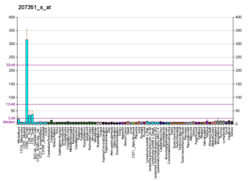SH2D2A
SH2 domain-containing protein 2A is a protein that in humans is encoded by the SH2D2A gene.[5][6]
Interactions
SH2D2A has been shown to interact with MAP3K2.[7]
References
- 1 2 3 GRCh38: Ensembl release 89: ENSG00000027869 - Ensembl, May 2017
- 1 2 3 GRCm38: Ensembl release 89: ENSMUSG00000028071 - Ensembl, May 2017
- ↑ "Human PubMed Reference:".
- ↑ "Mouse PubMed Reference:".
- ↑ Spurkland A; Brinchmann JE; Markussen G; Pedeutour F; Munthe E; Lea T; Vartdal F; Aasheim HC (March 1998). "Molecular cloning of a T cell-specific adapter protein (TSAd) containing an Src homology (SH) 2 domain and putative SH3 and phosphotyrosine binding sites". J Biol Chem. 273 (8): 4539–46. PMID 9468509. doi:10.1074/jbc.273.8.4539.
- ↑ "Entrez Gene: SH2D2A SH2 domain protein 2A".
- ↑ Sun, W; Kesavan K; Schaefer B C; Garrington T P; Ware M; Johnson N L; Gelfand E W; Johnson G L (February 2001). "MEKK2 associates with the adapter protein Lad/RIBP and regulates the MEK5-BMK1/ERK5 pathway". J. Biol. Chem. United States. 276 (7): 5093–100. ISSN 0021-9258. PMID 11073940. doi:10.1074/jbc.M003719200.
Further reading
- Marti F; Lapinski PE; King PD (2005). "The emerging role of the T cell-specific adaptor (TSAd) protein as an autoimmune disease-regulator in mouse and man.". Immunol. Lett. 97 (2): 165–70. PMID 15752554. doi:10.1016/j.imlet.2004.10.019.
- Maruyama K; Sugano S (1994). "Oligo-capping: a simple method to replace the cap structure of eukaryotic mRNAs with oligoribonucleotides.". Gene. 138 (1-2): 171–4. PMID 8125298. doi:10.1016/0378-1119(94)90802-8.
- Suzuki Y, Yoshitomo-Nakagawa K, Maruyama K, et al. (1997). "Construction and characterization of a full length-enriched and a 5'-end-enriched cDNA library.". Gene. 200 (1-2): 149–56. PMID 9373149. doi:10.1016/S0378-1119(97)00411-3.
- Choi YB; Kim CK; Yun Y (1999). "Lad, an adapter protein interacting with the SH2 domain of p56lck, is required for T cell activation.". J. Immunol. 163 (10): 5242–9. PMID 10553045.
- Rajagopal K, Sommers CL, Decker DC, et al. (2000). "RIBP, a novel Rlk/Txk- and itk-binding adaptor protein that regulates T cell activation.". J. Exp. Med. 190 (11): 1657–68. PMC 2195727
 . PMID 10587356. doi:10.1084/jem.190.11.1657.
. PMID 10587356. doi:10.1084/jem.190.11.1657. - Wu LW, Mayo LD, Dunbar JD, et al. (2000). "VRAP is an adaptor protein that binds KDR, a receptor for vascular endothelial cell growth factor.". J. Biol. Chem. 275 (9): 6059–62. PMID 10692392. doi:10.1074/jbc.275.9.6059.
- Dai KZ, Vergnaud G, Ando A, et al. (2000). "The SH2D2A gene encoding the T-cell-specific adapter protein (TSAd) is localized centromeric to the CD1 gene cluster on human Chromosome 1.". Immunogenetics. 51 (3): 179–85. PMID 10752626. doi:10.1007/s002510050029.
- Strausberg RL, Feingold EA, Grouse LH, et al. (2003). "Generation and initial analysis of more than 15,000 full-length human and mouse cDNA sequences.". Proc. Natl. Acad. Sci. U.S.A. 99 (26): 16899–903. PMC 139241
 . PMID 12477932. doi:10.1073/pnas.242603899.
. PMID 12477932. doi:10.1073/pnas.242603899. - Smerdel A, Dai KZ, Lorentzen AR, et al. (2005). "Genetic association between juvenile rheumatoid arthritis and polymorphism in the SH2D2A gene.". Genes Immun. 5 (4): 310–2. PMID 15129233. doi:10.1038/sj.gene.6364093.
- Gerhard DS, Wagner L, Feingold EA, et al. (2004). "The status, quality, and expansion of the NIH full-length cDNA project: the Mammalian Gene Collection (MGC).". Genome Res. 14 (10B): 2121–7. PMC 528928
 . PMID 15489334. doi:10.1101/gr.2596504.
. PMID 15489334. doi:10.1101/gr.2596504. - Rush J, Moritz A, Lee KA, et al. (2005). "Immunoaffinity profiling of tyrosine phosphorylation in cancer cells.". Nat. Biotechnol. 23 (1): 94–101. PMID 15592455. doi:10.1038/nbt1046.
- Matsumoto T, Bohman S, Dixelius J, et al. (2005). "VEGF receptor-2 Y951 signaling and a role for the adapter molecule TSAd in tumor angiogenesis.". EMBO J. 24 (13): 2342–53. PMC 1173150
 . PMID 15962004. doi:10.1038/sj.emboj.7600709.
. PMID 15962004. doi:10.1038/sj.emboj.7600709. - Gregory SG, Barlow KF, McLay KE, et al. (2006). "The DNA sequence and biological annotation of human chromosome 1.". Nature. 441 (7091): 315–21. PMID 16710414. doi:10.1038/nature04727.
- Park D, Park I, Lee D, et al. (2007). "The adaptor protein Lad associates with the G protein beta subunit and mediates chemokine-dependent T-cell migration.". Blood. 109 (12): 5122–8. PMID 17327418. doi:10.1182/blood-2005-10-061838.
This article is issued from
Wikipedia.
The text is licensed under Creative Commons - Attribution - Sharealike.
Additional terms may apply for the media files.




